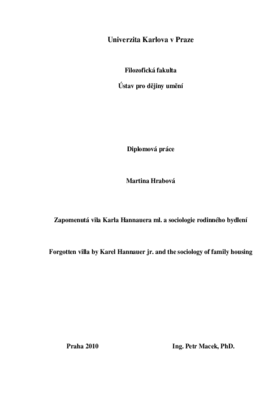Zapomenutá vila Karla Hannauera ml. a sociologie rodinného bydlení
Forgotten villa by Karel Hannauer and the sociology of family housing
diplomová práce (OBHÁJENO)

Zobrazit/
Trvalý odkaz
http://hdl.handle.net/20.500.11956/34592Identifikátory
SIS: 91061
Katalog UK: 990013716360106986
Kolekce
- Kvalifikační práce [24991]
Autor
Vedoucí práce
Oponent práce
Švácha, Rostislav
Fakulta / součást
Filozofická fakulta
Obor
Dějiny umění
Katedra / ústav / klinika
Ústav pro dějiny umění
Datum obhajoby
16. 9. 2010
Nakladatel
Univerzita Karlova, Filozofická fakultaJazyk
Čeština
Známka
Výborně
Impulsem k této práci byl archivní nález, který umožnil identifikaci raného díla architekta Karla Hannauera. Funkcionalistickou vilu, která byla dosud známá pouze z publikace v dobovém časopise, autorka odhalila v Praze - Libni skrytou pod radikální přestavbou z konce třicátých let. Práce sleduje několik tématických okruhů. Zabývá se účastí Karla Hannauera na formování československé meziválečné architektury a jeho podílu na transformaci zahraničních vlivů (především Le Corbusiera) na českou architektonickou tvorbu. Autorka se věnuje především architektuře rodinných domů a detailně popisuje čtyři vily, které Hannauer navrhl během deseti let před druhou světovou válkou. Sleduje také, jak se v souvislosti s politickými režimy měnila skladba uživatelů sledovaných domů, jak se proměňoval způsob jejich využití a s ním i podoba jednotlivých objektů. Práce se tak dotýká vztahu architektury a sociologie bydlení. Tomuto tématu se Hannauer teoreticky a pedagogicky věnoval zejména ve čtyřicátých a padesátých letech, kdy mu totalitní režimy zabránily pokračovat v architektonické práci. Vedle odborné literatury se práce opírá o studium archivní dokumentace, terénní výzkum a metody orální historie (v rozhovorech s pamětníky).
The impulse for this work was the archive discovery that enabled identification of an early work of the architect Karel Hannauer. In Prague quarter Libeň the author revealed a functionalist villa, previously known only from an article in a contemporary journal, hidden under a radical reconstruction made in the late thirties. The work covers several thematic issues. It deals with Karel Hannauer's participation in forming the Czechoslovak interwar architecture and his contribution to the transition of foreign influences (especially Le Corbusier's) to the Czech architectural design. The author focuses particularly on the architecture of family houses and in details describes four villas that Hannauer designed during the period of ten years before World War II. She also follows the changes of the political regimes influenced the structure of inhabitants and how the usage patterns and the appearance of the houses were changed during the time. By this way the thesis concerns also the relationship of the architecture and the sociology of housing. Coincidently Hannauer theoretically studied and taught the sociology of the architecture in the forties and fifties, when the totalitarian regimes restricted him from his architectonical work. Besides literature, the work is based on archival documentation studies, a...
